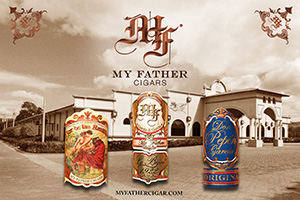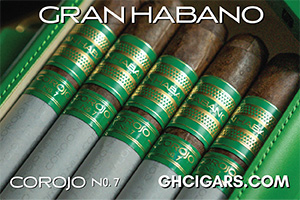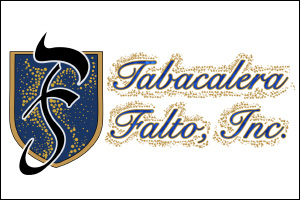Leaf Metamorphosis
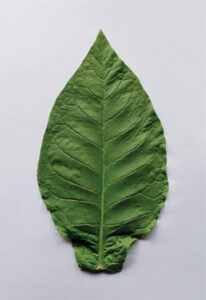 The following pictures are examples of what you may find inside the curing barns in different phases of the process. The first photo is from day 1, harvested right off of the plant. The last picture is of a fully cured leaf that is ready to be prepped for fermentation, at around 45 days where the entire leaf is consistent in color from stem to the edges of the leaf.
The following pictures are examples of what you may find inside the curing barns in different phases of the process. The first photo is from day 1, harvested right off of the plant. The last picture is of a fully cured leaf that is ready to be prepped for fermentation, at around 45 days where the entire leaf is consistent in color from stem to the edges of the leaf.
Each step of the cigar manufacturing process, whether from the cigar rolling floor in the factory, or the tobacco farms, is important and requires very specific attention. In this issue we look at curing tobacco leaves from the day they are harvested off of the plant through the curing process in tobacco barns. This is the first stage after the leaves are harvested. After the tobacco is cured in the barns, it will be sent off to fermentation. The curing process is basically hanging the leaves up in barns allowing them to slowly dry over the course of 25-45 days, slowly turning them from green to brown. Every tobacco grower may follow the same guidelines but may approach each step a little differently. This is basically a guideline for what generally happens with tobacco after it is harvested, through the curing process.
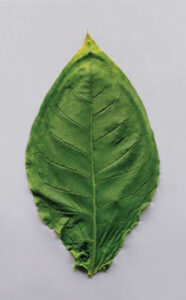 Tobacco harvested for cigars is picked by priming. Meaning that usually one or two sets of leaves will be picked off of a plant at a time. Starting from the bottom set of leaves, which are the oldest set of leaves on the plant and are the first to reach maturity. Different primings have different flavor and nicotine levels. A crop will be picked priming by priming in order for the tobacco to be catalogued and used specifically for it’s unique characteristics when making a cigar blend. There would be no other way to re-create the same cigar crop after crop if the tobacco was harvested all at once. You would get leaves that were not mature mixed in with mature leaves. Premium cigar tobacco is high quality and therefore treated with respect and time honored practices. Cigars utilize tobacco for its character, strength in flavor and body, and the nuances that each variety or region has to offer. One tobacco plant will have varying levels of flavors and strengths through each set of leaves. The three main primings, starting from the bottom, are volado, seco, and ligero. There are other known primings in between the main primings such as visus, which falls in between seco and ligero. When tobacco leaves are harvested they are stacked onto each other and crated away, usually in some sort of bin by tractor or truck. The leaves are then brought into the curing barns.
Tobacco harvested for cigars is picked by priming. Meaning that usually one or two sets of leaves will be picked off of a plant at a time. Starting from the bottom set of leaves, which are the oldest set of leaves on the plant and are the first to reach maturity. Different primings have different flavor and nicotine levels. A crop will be picked priming by priming in order for the tobacco to be catalogued and used specifically for it’s unique characteristics when making a cigar blend. There would be no other way to re-create the same cigar crop after crop if the tobacco was harvested all at once. You would get leaves that were not mature mixed in with mature leaves. Premium cigar tobacco is high quality and therefore treated with respect and time honored practices. Cigars utilize tobacco for its character, strength in flavor and body, and the nuances that each variety or region has to offer. One tobacco plant will have varying levels of flavors and strengths through each set of leaves. The three main primings, starting from the bottom, are volado, seco, and ligero. There are other known primings in between the main primings such as visus, which falls in between seco and ligero. When tobacco leaves are harvested they are stacked onto each other and crated away, usually in some sort of bin by tractor or truck. The leaves are then brought into the curing barns.
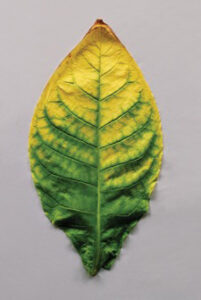 Once the tobacco has been brought to the curing barns, they must be prepared to hang on the racks. With a large needle and thick string, the tobacco leaves are sewn together by their stems and hung over a plank (most commonly you will see long thick tree branches used). Usually only women perform this job while the men carry the full planks of tobacco, scaling up into the barn’s racks and rafters in order to hang the tobacco. This will be done in one barn until all the racks are filled from the ceiling all the way to the floor. The number of days that the tobacco will stay in the curing barns will vary from priming to priming, and from farm to farm, but on average the process takes 25 to 45 days to complete. In an empty curing barn you’ll see wood racks that stretch from just a couple feet off of the ground, all the way up to the ceiling. Laths are used to hang the tobacco. They are straight tree branches or planks that hang between each of the racks. When they are full, the racks will be strung with tobacco leaves, floor to ceiling.
Once the tobacco has been brought to the curing barns, they must be prepared to hang on the racks. With a large needle and thick string, the tobacco leaves are sewn together by their stems and hung over a plank (most commonly you will see long thick tree branches used). Usually only women perform this job while the men carry the full planks of tobacco, scaling up into the barn’s racks and rafters in order to hang the tobacco. This will be done in one barn until all the racks are filled from the ceiling all the way to the floor. The number of days that the tobacco will stay in the curing barns will vary from priming to priming, and from farm to farm, but on average the process takes 25 to 45 days to complete. In an empty curing barn you’ll see wood racks that stretch from just a couple feet off of the ground, all the way up to the ceiling. Laths are used to hang the tobacco. They are straight tree branches or planks that hang between each of the racks. When they are full, the racks will be strung with tobacco leaves, floor to ceiling.
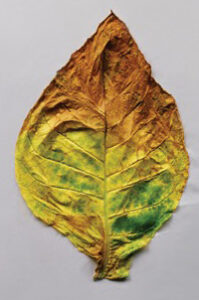 WHY DO LEAVES CHANGE COLOR, AND WHAT IS THE POINT OF THE PROCESS?
WHY DO LEAVES CHANGE COLOR, AND WHAT IS THE POINT OF THE PROCESS?
Harvested tobacco leaves contain approximately 85% water. The green in the leaves is chlorophyll. The curing process begins when the leaf begins to lose the chlorophyll. The yellow pigments are an indicator that chemical changes are happening in the leaf. All of the starch of the green leaf will transform into sugars (fructose and other simple sugars). Therefore the yellow pigment will appear, and eventually the sweet smell of partially cured tobacco will come through. The aroma comes on due to the transformed tobacco cells, which once again changes into alcohols and phenols *. All of this will happen within the existing humidity, approximately 75% RH, and the correct amount of heat, approximately 78 degrees Fahrenheit. The oxidation of those phenols causes the leaves to turn brown and a sweet smell is left behind.
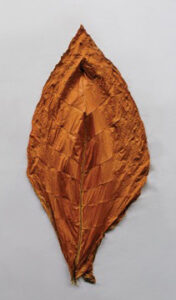 CURING BARNS:
CURING BARNS:
Curing barns are used to cure tobacco after the harvest. Usually all curing barns are set on the farms on the outskirts of the fields. After the curing process the tobacco is then sent to the fermentation warehouse for buying, separating the filler and binder, and to begin the fermentation process. Curing barns are different all over the world. Some have only a roof, while others are hi-tek and consist of a 100% controlled atmosphere where temperature and humidity can be precisely controlled (mostly used for wrapper tobacco). Traditionally curing barns were open aired with a thatch roof. Although this method is still used it is not the most efficient or the ideal condition for the tobacco to cure evenly due to the excess exposure to elements such as the sun and rain).
NOTE:
Why isn’t it just called drying? Curing simply refers to the process of slowly drying out the leaves over a period of time. Drying is a term used for candela leaves. Candela leaves are made by drying the leaves with a high heat over a short amount of time which will fix the green colors in the leaf.
Co-written by Thor Nielsen and Hendrik Kelner. Photos by Jake Fuller.







